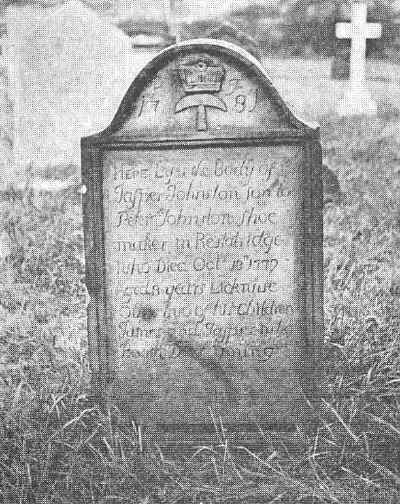This religious purpose
finds prominent mention in their charter of rights and privileges
incorporating the members of a craft or trade into a guild, which in
Scotland was always known as a "seal of cause" —itself a
continental term. These seals of cause, erecting the various trades into
guilds, were so named from the official seal attached to them, and were
granted by the overlord of the barony, who fixed his seal to them to show
that they were genuine. In Edinburgh, seals of cause were granted by the
provost and magistrates with the city seal attached; in North Leith by the
Abbot of Holyrood, who affixed the official seal of the Abbey; and in
South Leith by the Logans of Restalrig, whose seal contained their
coat-of-arms, a heart pierced with three nails in commemoration of the
family’s share in endeavouring to convey the heart of Bruce to the Holy
Land. These seals were of lead or wax, and were attached by a cord or
ribbon to the seal of cause or charter incorporating the members of a
trade into a guild.
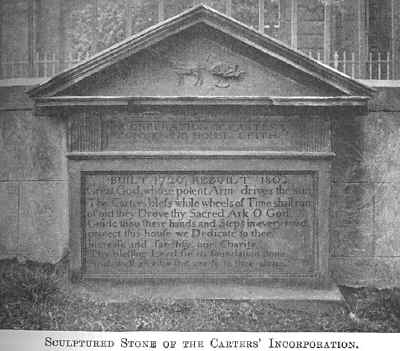
Most of these seals of
cause of the old Leith craft guilds no longer exist, and, considering how
often the town suffered in the centuries before the Union of the Crowns
from the destroying hand of the English invader, this is not surprising.
The oldest existing seal of cause seems to be that of the Tailors, granted
by Sir Robert Logan in 1515 shortly after succeeding his father, Sir John,
who fell at Flodden. The seal of cause of the Cordwainers’ or Shoemakers’
Guild, granted by this same Sir Robert, was destroyed when Leith was laid
in ashes by the ruthless Hertford in 1544. A new seal of cause was granted
them by his son, another Sir Robert, in 1550.
In this charter, as in all
pre-Reformation seals of cause, the religious side of the guild life
occupies the first place. The celebration of masses for the souls of
deceased members and the promotion of religious duties and services at the
altar of their patron saints, St. Crispin and St. Crispianus, were made a
first charge on their funds, to which each member contributed his weekly
penny, a relatively larger sum then than now. In all probability it is
from these funds subscribed by their members that the guilds received
their name, for the word seems to come from the Saxon word
"gild," which means a payment.
The head of each guild in
Scotland had an ecclesiastical title—deacon or kirk-maister usually, but
sometimes dean - derived no doubt, from the fact that he received the
weekly offerings and paid all the expenses of its special altar and
services in the parish church. The Dean of Guild, the head of the local
trade incorporations in Scotland, is always, as in Edinburgh, a member of
the Town Council. In Leith this office was generally held by the provost.
The harbour Porters or Pynouris (Pioneers), as they were then called, are
mentioned as far back as 1496, and the Carters or Slaiders (sleighers) in
1555. The latter possess several old charters no longer decipherable, in
one of which can be made out that they spread a crimson cloth in front of
the King’s Wark at the landing there of some old-time queen, perhaps the
good Queen Margaret of Denmark, or the gentle Madeleine of France, or, it
may be, the fairest but most hapless of all, Queen Mary herself.
‘The Leith Tailors’ Guild or
Craft, as it was more commonly called in the old Catholic days in
Scotland, was unable to afford a special altar of its own, but adopted
that of St. Anthony in the hospital church of that name in St. Anthony’s
Wynd, supporting it by their weekly pennies. The Tailors of North Leith
joined their brethren of the Canongate at the altar of St. Anne, the
mother of the Virgin and the true patron saint of tailors, in Holyrood
Abbey. A little chapel to the same saint once stood just east of the great
Abbey church, and is remembered today in the names St. Anne’s Yards and
St. Anne’s Brewery.
North Leith, in those long
past pre-Reformation days, was merely a village, and not a large one at
that. The members of each of its various trades were too few to support an
altar of their own, and, like their fellows of the tailor craft, continued
to associate themselves with their brethren of the Canongate in the upkeep
of the trade altar and patron saint at Holyrood, even after Abbot
Ballantyne had founded and built in their midst the Church of St. Ninian.
In post-Reformation times ship carpenters were the chief craftsmen in
North Leith, for most of our shipyards have always been on the north side
of the water, but in pre-Reformation times the shipbuilding industry had
not arisen in North Leith. The only other North Leith craft guild of which
we have any knowledge at this time was that of the Hammermen, who, as
their seal of cause informs us, combined with the members of the craft in
the Canongate in holding their services in the Abbey, at the altar of St.
Eloi, St. Eloi everywhere throughout Europe being the patron saint of the
Hammermen’s craft, which included all workers in metals.
Besides the Tailors’ and
Cordwainers’ Guilds in South Leith, we find those of the Coopers,
Baxters or Bakers, Fleshers, Websters or Weavers, and Hammermen, who must
all have had their altars and chaplains either severally or jointly in
their great Church of St. Mary in the Kirkgate. Several of the old guild
chapels, like the Edinburgh Masons’ and Wrights’ chantry of St. John,
are still to be found in St. Giles’, but have, of course, never been
used since the Reformation by the trade guilds who formerly owned them. Of
the chantry chapels in the parish church that once belonged to the crafts
in Leith and the religious activities associated with them hardly a
tradition now remains, showing that a large part of Leith’s history is
lost beyond recall; and yet these guilds must have powerfully influenced
the religious, social, and industrial life of the town, for within their
membership were enrolled the names of all the craftsmen and seamen of the
town.
Had the records of those
mediaeval Leith guilds still existed as do those of the Edinburgh
Incorporation of Hammermen what an interesting light they would "aye
shied on the story of Leith! There would have been much in those records
about the numerous Church festivals, that is, holydays, and therefore
holidays—which were held in honour of the patron saints of the various
crafts, and especially about Corpus Christi Day, which generally fell
about the beginning of June, and was the great holiday of the year
everywhere in Christendom. On that day all the craft guilds of the town
went in procession through the streets, the members walking two and two in
gala dress, bearing with them banners and other emblems, and forming a
spectacle of the greatest splendour, each craft vying with its neighbour
in the magnificence of its display.
The clergy of St. Mary’s
and St. Ninian’s would avail themselves of the opportunities afforded by
the solemn processions of the day to improve the religious education of
the people. This they did by means of miracle plays, so called because
they were representations of the life and miracles of some saint, or of
events recorded in the Scriptures. The performers were the members of the
trade guilds, each guild having its own play, and their theatre was the
street. Perhaps the ancient Kirkgate inn, with the quaint and picturesque
sign of Noah’s Ark over the door, was a reminiscence of the miracle play
of that name always performed by the Seamen’s Guild on Corpus Christi
Day. The annual procession in London on Lord Mayor’s Day is the only
reminder we now have in our country of these old trade processions and
pageants.
Perhaps, however, the most
important part of the business of a trade guild was to protect its members
and their trade against the competition of outsiders. Fair rivalry in
trade in pre-Reformation times, and, indeed, for long after, was a thing
unknown in Europe, and woe betide the stranger of those days who came to
Leith and tried to make shoes or clothes or act as a smith, without being
a member of the craft guild. His goods would be at once confiscated, and
he might deem him-self lucky if he was simply expelled from the town with
out being first sent to prison. Nowadays a man may sell what he pleases
and work at his trade wherever he may wish, but such freedom was
impossible under the old trade guilds. When Edinburgh became feudal
superior over Leith in place of the Logans, she declared that Leith, being
an unfree town, had no right to have trade guilds at all, and threatened
to imprison any deacons of these that the Leithers might elect. The
Leithers, however, persisted in retaining their guilds and their deacons,
but for this privilege their guilds had to pay heavy dues to the
corresponding Edinburgh trade guilds, and thus, just as Leith was the
vassal of Edinburgh, so its trade guilds were subordinate to, and in a
certain sense subject to, the jurisdiction of those of Edinburgh.
The prohibitory laws of the trade
guilds compelled strangers to settle just outside the towns, where they
formed new suburbs, in order to be free to carry on their trade. In this
way arose in Leith the suburb of Yardheads, on the lands of the canons of
St. Anthony. One would have expected that Leith’s unhappy experiences at
the hands of the Edinburgh merchant and trade guilds would have taught her
to see the injustice of these old-world narrow and exclusive trade
notions, and to have consideration and sympathy for the stranger craftsman
who came to live within her gates; but it was not so. On the contrary, she
acted towards strangers exactly in the same narrow and selfish spirit from
which she herself suffered so much. Thus in 1676 we find all the Leith
trade incorporations sending in a petition to the Kirk Session as
superiors of the Yardheads to take some action "anent ye unfree men
that live in ye Yardheads by whom they afledge they are injured in their
respective trades." When such was the attitude of Leith in matters of
trade in spite of the fact that all she suffered as a town resulted
from the same unjust and tyrannical spirit, we can hardly be surprised at
similar notions prevailing among the merchant burgesses of Edinburgh.
The Leith guilds had the
monopoly of trade within the town, and all who were not members were
unfree men in the eyes of the Leithers, just as they themselves were
unfree in the eyes of Edinburgh. At an earlier date, in 1630, the Tailors’
Guild complained to the Session and Bailies against the uncouth (stranger)
tailors in the town, and the Session and Bailies thought the complaint a
very just and reasonable one, and determined to prohibit the
"uncouth" tailors from plying the needle any longer within the
bounds of the town. The Kirk Session of the parish church, from the
Reformation down to 1833, seem to have exercised many of the powers now
vested in the Town Council, and the two Edinburgh bailies who were deputed
by the city to rule Leith were in virtue of their office always members of
the Kirk Session.
After the Reformation the
trade guilds, under the name of trade incorporations, became more
important bodies than before in Leith, and wielded a large influence both
in Church and local affairs. Leith, being a vassal town, had no town
council, and the only way in which the people could express their wishes,
and unite together to have them carried out, was through their trade
incorporations, which, in consequence, occupy a very important place in
local records. In Edinburgh and other royal burghs the local records are
the burgh records, recording the acts of the Town Council, whose place in
Leith was largely taken by the Kirk Session of the parish church. It is to
the Session records of South Leith Church we must go if we wish to become
intimately acquainted with the people of Leith and many of their doings
from the days of James VI. down to 1833, when Leith obtained a town
council of her own.
The trade incorporations of
Leith during that long period practically represented the whole of the
people of the town gathered together in groups according to their
occupations. The Leith trade incorporations were divided into four groups:—
1. The skippers and mariners of the
Trinity House.
2. The maltmen, brewers, and sledders or carters.
3. The craftsmen and meal men.
4. The traffickers, and all other
gentlemen and indwellers in Leith not members of any of the other
corporations.
The oldest and wealthiest
of these incorporations is that of the Masters and Mariners of the Trinity
House in the Kirkgate. From time immemorial they had received certain dues
called the "prime gilt" on each ton of goods from all vessels
unloading at the port. These dues were abolished in 1872, but out of the
funds thus obtained they erected a seamen’s hospital or almshouse for
the keeping of "poor, old, infirm, and weak mariners." This
hospital, like mariners’ guilds in other ports, they dedicated to the
Holy Trinity. The hospital was demolished in 1816, and the present Trinity
House erected on the site as a guild hall for the meetings of the Masters
of the Incorporation.
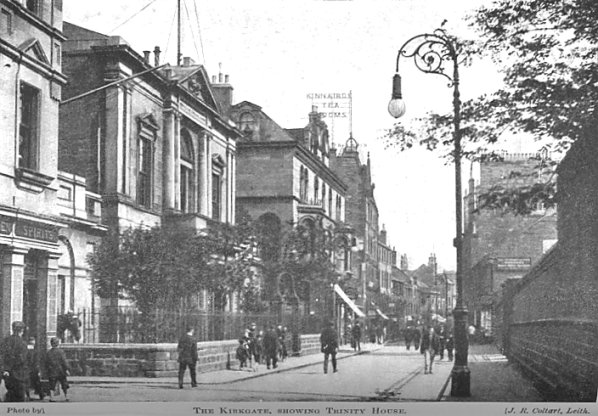
The convening-room of the
Incorporation is a very handsome and stately apartment, and contains an
interesting collection of objects, all more or less associated with those
who "go down to the sea in ships." Among these are Raeburn’s
fine portrait of Admiral Duncan, the hero of Camperdown, and next to it
that of Captain Brown, the master of the Trinity House who sailed the
admiral’s flagship, the Venerable, throughout the bold manoeuvres of
that stirring sea fight. Captain Brown’s descendants are well-known
citizens of the town today. Facing Admiral Duncan’s portrait, at the
opposite end of the hall, is Scott Lauder’s huge picture of Vasco da
Gama passing the Cape of Good Hope. Here, too, may be seen an ancient
portrait of Mary of Guise and a model of the vessel La Belle Esperance in
which a more than doubtful tradition would have us believe she came to
Scotland, while in the entrance hail stands a huge antique and richly
carved piece of furniture, the Incorporation charter chest of former days.
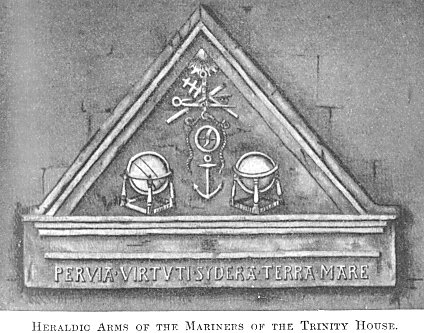
The carved stones which
once adorned the front of the old building are now built into the gables
of the present Trinity House. The one in the south gable, which
sets forth the date, and at the same time the purpose of the ancient
erection, is in very quaint and picturesque spelling and lettering, all of
the olden time, as may be seen from the illustration below. The second
stone shows the motto and heraldic emblems of the Mariners’
Incorporation, representing the cross-staff and other nautical instruments
in use in the sixteenth century when the old hospital was built. Beneath
this is a modern tablet bearing this legend:—
"INSTITUTED 1380. BUILT
1555. REBUILT 1816."
Their prime-gilt dues on
all shipping entering the harbour were abolished in 1872, but long before
that date the Masters and Mariners of the Trinity House had become a
wealthy corporation. They had invested much of their funds in land in
Trinity, which takes its name from their incorporation, and from their
annual income they provide pensions for old members and the widows and
families of those of their own number. Thus the Masters and Mariners of
the Trinity House of today carry on the same benevolent work as the
ancient guild of the Holy Trinity, and though the exterior of their guild
hall today has nothing in its appearance to suggest the long history of
the Incorporation, we have only to step inside to feel that the
institution has a tradition behind it that goes back through many
centuries.
As an almshouse for their
poor the other three trade incorporations had King James’s Hospital,
whose site is marked by the inscribed panel in the wall of South Leith
Churchyard in the Kirkgate. But besides the Mariners’ Hospital of the
Trinity House and the New or King James’s Hospital (the successor of the
old or St. Anthony’s hospital) several of the other trade incorporations
had almshouses for the poor and decayed members of their own trade. One of
these, now sorely troubled with old age like the pensioners who once
occupied it, still survives in Water Street. Over the central gable is an
inscribed panel which gives all we need know of the history of the
building in a nutshell.
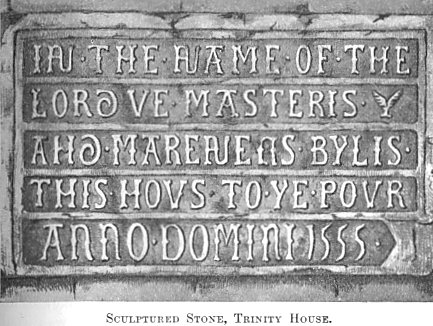
1723.
We Coopers In The Town Of Leith Built This House For The Use Of Our Poor.
Renewed 1827.
The buildings of King James’s
Hospital not only provided accommodation for many of the poor of all the
trade incorporations save the Mariners’, but were also used by some of
them as their guild hall. But, like the Mariners’, some of the trade
incorporations seemed to possess convening
houses of their own for the transaction of their business. These convening
houses have now disappeared, but the sculptured stones which embellished
the fronts of three of them still remain. That of the Carters shows a
carter in charge of a horse and vehicle, and is now built into the inside
wall of South Leith Churchyard. The other two sculptured stones are those
of the Carpenters of North Leith in Carpenters’ Land, and of the Leith
Wine Porters or Stingmen, as they were called because they carried their
burdens slung from a sting, stang, or pole, as is shown in one of the
illustrations to Chapter XXXII.
It was the trade incorporations that
gave the first blow to Edinburgh’s supremacy over Leith. In 1731 they
determined to test the legality of the dues exacted from them by the
incorporated trades of Edinburgh. They brought their grievances before the
Court of Session, who in 1734 declared their charters, granted by Logan of
Restalrig, good and valid, and their incorporations to be free and
independent of those of the city. The distinction between freemen and
unfreemen was still maintained, however, in the dues exacted by the
Edinburgh Town Council for the importing and weighing of goods at the
harbour of Leith, unfreemen, among whom Leithers were included, generally
paying twice as much as the free and privileged burgesses of Edinburgh who
lived some two miles away. The distinction between freemen and unfreemen,
however, in Leith, as elsewhere in Scotland, ended with the Burgh Trading
Act of 1846, when the special privileges of the trade incorporations were
swept away, and it was made lawful for any person to deal in merchandise,
and to carry on or exercise any trade without being a burgess or guild
brother, or a member of any guild or incorporation.
In their day of power these
guilds or incorporations played a great part in the social, religious, and
industrial life of Leith. The tombstones of their members in Restalrig and
North and South Leith churchyards, often beautifully adorned with the
mottoes and heraldic emblems of their craft, show their pride in having
been members of their trade incorporations, whose importance was
recognized even down to the early decades of the nineteenth century by the
appointment of their Masters to service in the police commission, who
looked after law and order in Leith when she was still under the dominion
of Edinburgh, and had no town council of her own. And we today are
reminded of the great part once played by these incorporations by the
inscription on the pediment of the Town Hall in Constitution Street, which
bears to be "erected by the Magistrates, and Masters of the Trade
Incorporations."
